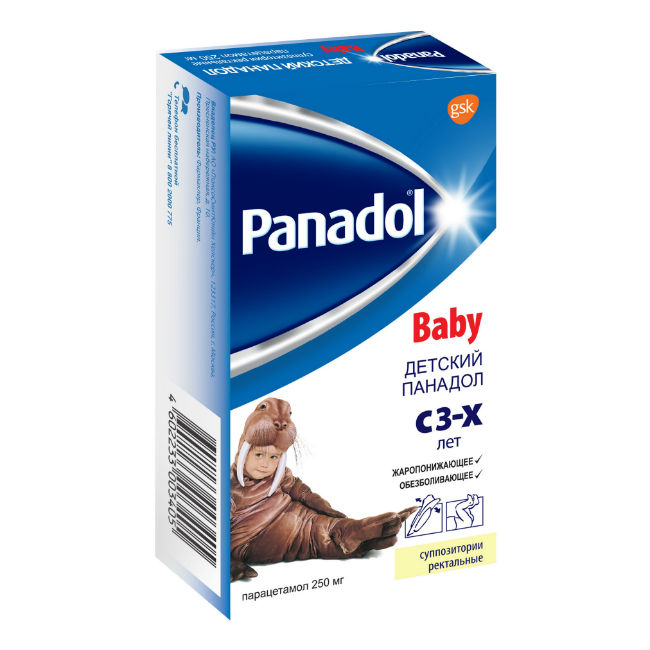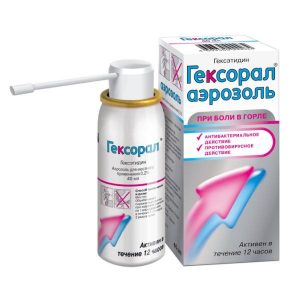Description
Description
White or almost white homogeneous, oily-looking suppositories of conical shape, without physical defects and visible inclusions and heterogeneities.
Latin name srdrdrpol Pan Pan
Release form
Rectal suppositories. 5 suppositories in strips of polyvinyl chloride and polyethylene.
2 strips are placed in a cardboard box with instructions for use.
Pharmacological action
The drug has analgesic and antipyretic properties.
Blocks cyclooxygenase in the central nervous system by acting on pain and thermoregulation centers.
There is virtually no anti-inflammatory effect.
Does not affect the condition of the gastrointestinal mucosa and water-salt metabolism, since it does not affect the synthesis of prostaglandins in peripheral tissues.
Indications
The drug Children’s Panadol is used in children from 5 years to 11 years old, having a body weight of 16 to 40 kg, as: antipyretic drugs – to reduce fever against colds, flu and childhood infectious diseases (chickenpox, mumps, measles, rubella, scarlet fever, whooping cough, etc.), as well as after vaccination.
Anesthetic (for pain of mild to moderate intensity) for: toothache, including teething or toothache headache and migraine sore throat pain in the muscles and joints of ear pain with otitis media.
Contraindications
Children’s drug Panadol is not recommended for patients with:
hypersensitivity to paracetamol or any other component of the drug
impaired liver and kidney function severe
blood diseases
recent inflammation or bleeding in the rectum (contraindication related to the route of administration)
genetic absence of glucose-6-phosphate dehydrogenase while taking other paracetamines medicines, medicines to relieve the symptoms of colds and flu, painkillers and antipyretic medicines for children ozraste to 5 years.
Use during pregnancy and lactation
Paracetamol crosses the placental barrier. To date, there has been no adverse effect of paracetamol on the fetus in humans.
Paracetamol is excreted in breast milk: the content in milk is 0.04-0.23% of the dose taken by the mother.
If you need to use paracetamol during pregnancy and lactation (breastfeeding), you should carefully weigh the expected benefits of therapy for the mother and the potential risk to the fetus or child.
In experimental studies, the embryotoxic, teratogenic and mutagenic effects of paracetamol have not been established.
Composition
1 supp. paracetamol 250 mg
Excipients:
solid fats.
Dosage and administration
For rectal administration.
Do not exceed the indicated dose!
Use the lowest dose necessary to achieve an effect within the shortest possible time!
The minimum interval between drug administrations should be at least 4 hours. Wash your hands and release the suppository from the plastic shell before administering the drug.
Gently insert the suppository with your index finger into the anus of the baby (preferably after a cleansing enema or spontaneous bowel movement). It will be easier to enter when the child is on the left side with one leg pulled up to the stomach.
The maximum daily dose of the drug is 60 mg / kg of body weight of the child, administered at 10 – 15 mg / kg of body weight 3-4 times a day every 4 to 6 hours.
Children with a body weight of 16 to 31 kg (usually 5 to 9 years) – 1 suppository (250 mg) no more than 4 times a day.
Children with a body weight of 32 to 40 kg (usually 10-11 years) – 2 suppositories of 250 mg no more than 4 times a day.
It is not recommended to take the drug as an antipyretic for more than 3 days without consulting a doctor.
Do not take concomitantly with other paracetamol-containing agents, agents for alleviating the symptoms of the common cold and flu, as well as ethanol-containing agents.
If symptoms of the disease persist while taking the drug, consult a doctor.
If you exceed the recommended dose, seek immediate medical attention, even if you feel well. An overdose of paracetamol can cause liver and kidney failure.
Special patient groups
Patients with impaired renal function
Before using the drug Children’s Panadol, patients with impaired renal function should first consult a doctor. Limitations associated with the use of drugs containing this active substance in patients with impaired renal function are mainly associated with the content of paracetamol in the drug.
Patients with impaired liver function:
Before using the drug Children’s Panadol, patients with impaired liver function should first consult a doctor. Limitations associated with the use of drugs containing this active substance in patients with impaired liver function are mainly associated with the content of paracetamol in the drug.
Side effects of
At recommended doses, the drug is usually well tolerated.
The following adverse reactions were identified spontaneously during post-registration use of the drug.
Adverse reactions are classified according to body systems and according to the frequency of development. The frequency of adverse reactions is defined as follows: very often ( 1/10), often ( 1/100 and <1/10), infrequently ( 1/1000 and <1/100), rarely ( 1/10 000 and <1/1000), very rarely (<10 000), the frequency is unknown (the frequency cannot be estimated from the available data). Paracetamol rarely has a side effect. Disorders of the blood and lymphatic system: Very rarely: thrombocytopenia, anemia, leukopenia, agranulocytosis. Immune system disorders: Very rare: anaphylactic shock, skin hypersensitivity reactions, including skin rash, urticaria, angioedema (Quincke’s edema), Stevens-Johnson syndrome, toxic epidermal necrolysis. Disorders of the respiratory system, chest and mediastinal organs: Very rare: bronchospasm in patients with hypersensitivity to acetylsalicylic acid and intolerance to other non-steroidal anti-inflammatory drugs. Disorders of the liver and biliary tract: Very rarely: impaired liver function. Nausea and vomiting are sometimes possible. If any of the adverse reactions listed in the instructions are exacerbated, or if you notice other adverse reactions not listed in the instructions, notify your doctor. Stop taking the drug and consult a doctor immediately if you experience: – The adverse reactions listed above. – Allergic reactions, such as a skin rash or itching, sometimes accompanied by breathing problems, swelling of the lips, tongue, throat, or face – Skin rash or peeling of the skin, or oral ulcers – Bruises and bleeding for an unexplained cause – Respiratory problems when taking aspirin or NSAIDs with a history of – History of breathing problems while taking Pediatric Panadol. Drug Interaction If your child is already taking other medicines, your baby’s Panadol should consult your doctor before taking this medicine. Barbiturates, carbamazepine, phenytoin, diphenin, primidone and other anticonvulsants, ethanol, rifampicin, zidovudine, flumecinol, phenylbutazone, butadione, St. John’s wort preparations and other inducers of microsomal oxidation increase the production of hydroxylated active metabolites, causing the possibility of severe liver damage with small overdoses of paracetamol (5 g or more). Inhibitors of microsomal liver enzymes reduce the risk of hepatotoxic action. Under the influence of paracetamol, the elimination time of levomycetin (chloramphenicol) increases 5-fold, which increases the risk of levomycetin (chloramphenicol) poisoning. With regular intake for a long time, the drug increases the effect of indirect anticoagulants (warfarin and other coumarins), which increases the risk of bleeding. Episodic intake of a single dose of the drug has no significant effect on the effect of indirect anticoagulants. Metoclopramide and domperidone increase, and cholestyramine reduces the absorption rate of paracetamol. The drug may reduce the effectiveness of uricosuric drugs. Overdose The drug should only be taken at the recommended doses! In case of suspected overdose, even with good health, it is necessary to discontinue use of the drug and consult a doctor immediately, as. there is a risk of delayed serious liver damage and hospitalization may be required. Symptoms Liver overdose may develop liver paracetamol, which may lead to liver transplantation or death. For the first 24 hours, it is possible: pale skin, nausea, vomiting, stomach pain, sweating. After 24-48 h after overdose, clinical signs of impaired liver function (pain in the liver, increased activity of hepatic transaminases) may manifest and reach a maximum by the fourth or sixth day. There may be signs of impaired carbohydrate metabolism and metabolic acidosis. Toxic effect in adults is possible after taking more than 10 g of paracetamol, in children – when taking more than 125 mg / kg of body weight of the child. If a patient has a glutathione deficiency due to malnutrition, cystic fibrosis, HIV infection, fasting or overdose can be achieved with smaller doses. In the case of severe poisoning, severe hepatic insufficiency may develop up to hepatic encephalopathy, the need for liver transplantation, coma and death, and hemorrhage, hypoglycemia, and brain edema may also occur. Acute renal failure with acute tubal necrosis, which is diagnosed by severe lumbar pain, hematuria and proteinuria, can develop without severe liver dysfunction. Cardiac arrhythmia and pancreatitis have been reported with paracetamol overdose. Hepatotoxic and nephrotoxic effects (renal colic, nonspecific bacteriuria, interstitial nephritis, papillary necrosis) may be observed with prolonged use with excess of the recommended dose. At the first signs of an overdose, it is urgent to consult a doctor, even in the absence of clear symptoms of poisoning. In the early period, symptoms may be limited only by nausea and vomiting and may not reflect the severity of the overdose or the degree of risk of damage to the internal organs. Treatment: With an overdose caused by the administration of paracetamol rectally, gastric lavage and enterosorbents are ineffective. Four or more hours after the presumed overdose, determination of the concentration of paracetamol in the blood plasma is required (earlier determination of the concentration of paracetamol may be unreliable). Acetylcysteine treatment may be performed up to 24 h after paracetamol administration, however, the maximum hepatoprotective effect may be obtained within the first 8 h after overdose, then the effectiveness of the antidote drops sharply. Acetylcysteine may be administered intravenously if necessary. In the absence of vomiting, an alternative option (in the absence of rapid inpatient care) is the appointment of methionine inside. The need for additional therapeutic measures (further administration of methionine, intravenous acetylcysteine) is determined depending on the concentration of paracetamol in the blood, as well as the time elapsed after its administration. Treatment of patients with severe hepatic impairment 24 hours after paracetamol administration should be performed in conjunction with specialists at the toxicology center or specialist liver disease department. Storage conditions At a temperature not exceeding 25 ° C. Keep out of the reach of children. Expiration 5 years. Do not use after the expiry date stated on the packaging. Active ingredient Paracetamol dosage form PMA Formulation rectal GlaxoSmithKline, United Kingdom




